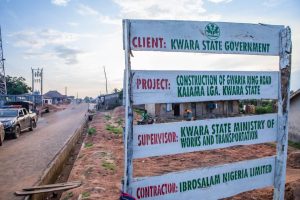Hussaini Abdu (Ph.D)
The distance from Kaama (Kaiama) to Abuja is just under 600 kilometres, a journey that typically takes no more than six hours by road. Over the years, I have driven this route from Kano several times, even managing to make a return trip in a single day on two occasions. However, in recent years, the journey has become increasingly arduous. From Abuja, the trip now takes at least 10 hours, often more, depending on the route and the season. When I received this year’s invitation to attend the Gani festival, I hesitated. The deteriorating road conditions and the physical and mental toll of such a long journey made the decision difficult.
 Hoping to make the journey easier, I chose to fly to Ilorin and then drive to Kaama—a decision I later regretted. I had to spend the night in Ilorin before continuing the trip the next day. The drive from Ilorin to Kaama, which should have taken three to four hours, stretched to nearly seven. The return journey was no better, forcing me to spend another night in Ilorin.
Hoping to make the journey easier, I chose to fly to Ilorin and then drive to Kaama—a decision I later regretted. I had to spend the night in Ilorin before continuing the trip the next day. The drive from Ilorin to Kaama, which should have taken three to four hours, stretched to nearly seven. The return journey was no better, forcing me to spend another night in Ilorin.
Road infrastructure in Nigeria is, generally, a challenge but the situation in Kaama is particularly dire. The town is traversed by federal roads that have long been neglected. The northern stretch, from New Bussa to Kaama, was constructed in the late 1980s but had deteriorated by the mid-1990s. It remained impassable for decades until 2019 when the federal government awarded a reconstruction contract to Gilmo Construction Company. The project which was supposed to take four years, is now in its sixth year. So far, only 10 kilometres of the road have been completed, primarily due to insufficient funding.
The southern route, which connects Kaama to Ilorin has never been paved and has become a subject of political manipulation. It is likely one of the few federal roads in Nigeria that remains unconstructed since independence from colonial rule. Despite numerous election promises, no progress has been made. Residents suggest that successive state governments may have received federal funding for construction without executing the work. This chronic neglect has left the local government area isolated, stifling its development and daily life.
The Gani festival, celebrated across West Africa since the 15th Century, is deeply rooted in both Islamic and indigenous traditions. While commonly linked to the Prophet Muhammad’s birthday (Maulud Nabiyyu), the festival predates the spread of Islam in Borgu and was never exclusively Islamic. Gani is believed to be associated with the “Sawarian tradition” of West African Islam, attributed to Al-Hajj Salim Suwari in the 15th Century. This tradition promoted social pluralism, allowing Muslims to coexist and cooperate with non-Muslims without seeking conversion. Over time, these interactions fostered the development of shared cultural practices like Gani, which spread across West Africa, uniting Muslim and non-Muslim communities alike.
Historically, Gani extended beyond Borgu, celebrated in various regions under different names. For example, the Mandinka/Malinke of Mali and Guinea-Conakry call it Domba or Danba, referring to the same lunar month. Similarly, the Juula/Dyula of northern Côte d’Ivoire and the Dagomba of northern Ghana celebrate Damba. Despite its Islamic associations, Gani’s religious character diminished over time, focusing more on feasts and tributes to senior kings. This tradition extended to Hausaland and Borno, where Gani was celebrated during the month known as Watan Gani or Takutaha, which coincided with Rabi’ al-Awwal. Similar customs were observed by the Nupe people and communities along the Niger-Benue confluence, where Gani was celebrated until as recently as 1952.
 Gani embodies a fusion of Islamic and indigenous traditions, with each region integrating these dualities in distinct ways. In some places, like Dagomba and Gonja in Ghana, Gani evolved into a national festival celebrated by both Muslims and non-Muslims. In Borgu, it retained its association with traditional and Islamic practices.
Gani embodies a fusion of Islamic and indigenous traditions, with each region integrating these dualities in distinct ways. In some places, like Dagomba and Gonja in Ghana, Gani evolved into a national festival celebrated by both Muslims and non-Muslims. In Borgu, it retained its association with traditional and Islamic practices.
Despite its rich history, Gani’s prominence has waned in many parts of West Africa since the 19th Century. The rise of Islam, particularly the spread of Sufi orders like the Qadiriyya and Tijaniyya, contributed to the decline of Gani, replacing it with Maulud, stripped of traditional rites. Today, only a few places, like Hadeija, Damagaran, and Daura, continue to observe Gani. The growing influence of Salafism and Wahhabism, which reject practices like Gani and Maulud, has further diminished its observance. Nonetheless, Borgu remains one of the few places where Gani endures as a cultural rather than religious tradition.
In Borgu’s principalities, particularly Kaama, Gani is closely intertwined with royalty and is the most important cultural celebration. The festival follows a similar pattern across major polities, shaping the cultural and calendrical rhythm of the people. Gani is more than a festival; it marks a pivotal month in the lunar calendar, influencing the community’s activities before and after the event. Historically, it was a state and aristocratic festival, providing a platform for Borgu Emirs to assert their authority and blend indigenous practices with early Islamic influences.
The festival’s evolution has been shaped by various socio-economic factors, including the rise of an educated elite, salaried workers, and politicians, the increasing ethnic-cultural diversity of many of the communities, as well as the expansion of markets and trade. These dynamics have influenced Gani’s duration and practices, reflecting the region’s shifting political economy. The grand finale of the festival, Ne Miiboo (the initiation of royals), or Gani-zii (Gani Day), is the highlight, featuring cultural dances, tributes to the King, and the reaffirmation of loyalty by subordinate kings, princes, and titleholders. In pre-colonial times, failure to attend without valid reason was considered an act of dissent, punishable by serious sanctions. The initiation of young royals under the supervision of the Kiyezide (a senior female council member) is also a crucial part of the festival, which concludes with a farewell ceremony called Kaazi’a, where traditional titles are conferred and bestowed upon deserving community members. During this event, gifts are presented to key individuals and groups who contributed to the festival’s success, marking a ceremonial conclusion to the festivities.
Despite the excitement of attending the Gani festival after years of absence, it was deeply troubling to see that the region’s road crisis remains unchanged. For an agrarian community like Kaama, roads are essential for connecting people to markets. Without proper infrastructure, the production and supply chain remains weak and unprofitable, limiting food security and economic opportunities. This crisis exposes deeper flaws in Nigeria’s federal system. Why should the federal government be responsible for roads connecting local government capitals? The disconnect between federal responsibilities and local needs is stark, with state governments often abdicating their duties by claiming the roads fall under federal jurisdiction. Even when state authorities step in, projects are frequently poorly executed, marred by mismanagement of funds.
The road crisis in Kaiama stands as a glaring symbol of government neglect. The two old Borgu local governments in Kwara State—Kaiama and Baruten—comprise nearly half of the state’s landmass, yet they remain completely cut off. The problem extends beyond physical isolation; these communities are severed from relatives and cultural ties in neighbouring Niger and Kebbi states, further deepening their exclusion from opportunities for growth and development. Conversations with stakeholders reveal a mix of frustration and resignation. As one community leader put it, “Only God can do this for us; we’ve tried everything possible.” This sense of helplessness highlights a broader issue of marginalization, prompting critical questions about whether this neglect reflects deliberate discrimination against ethnic minorities in the state.
I am not just frustrated by the roads—I am deeply embarrassed. It is disgraceful that a community as large and economically significant as Kaama is forced to endure such terrible road conditions while federal and state governments boast of building costly overhead bridges and underpasses in capital cities. The irony is striking, bridges are being built where there are no rivers, while communities that desperately need bridges are left stranded. Kaama, with its rich history in northern Nigeria, is a victim of both colonial and post-colonial neglect.
While I congratulate the Emir of Kaama, Alhaji Muazu Shehu Omar and the Emirate Council for this year’s Gani festival, I hope that the glaring infrastructure challenges spur both citizens and institutions into action. Every Nigerian deserves to live a life of dignity, and that cannot be achieved when basic infrastructure like roads is absent.
The author, an Abuja-based international development expert, is the current Country Director, CARE International.


